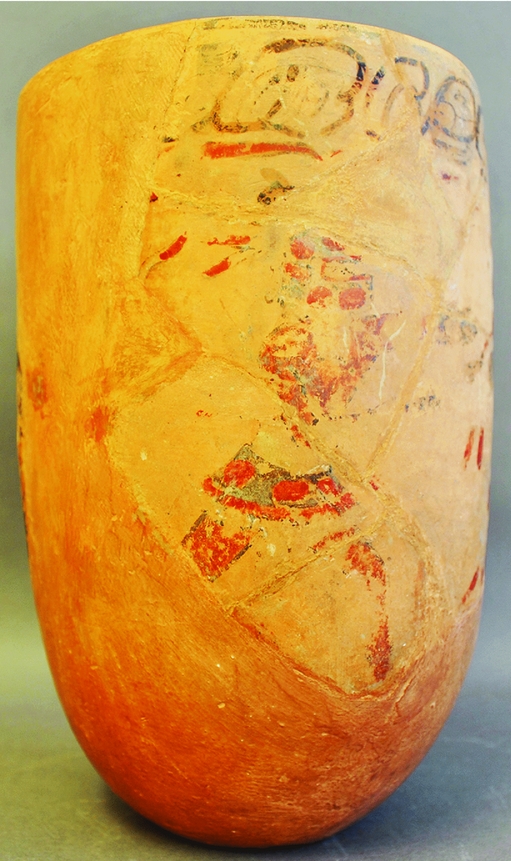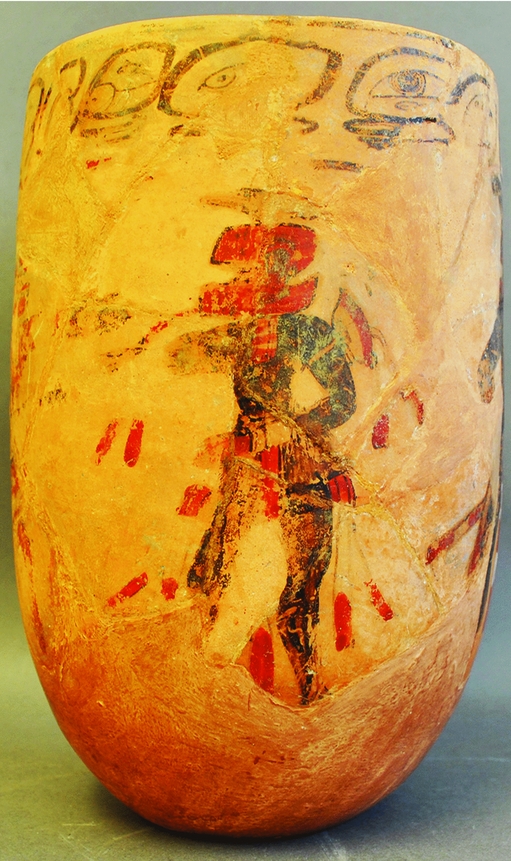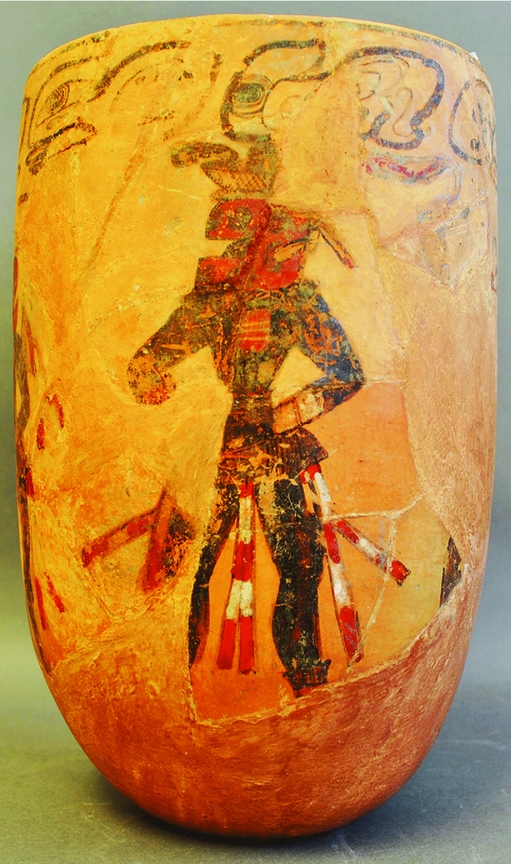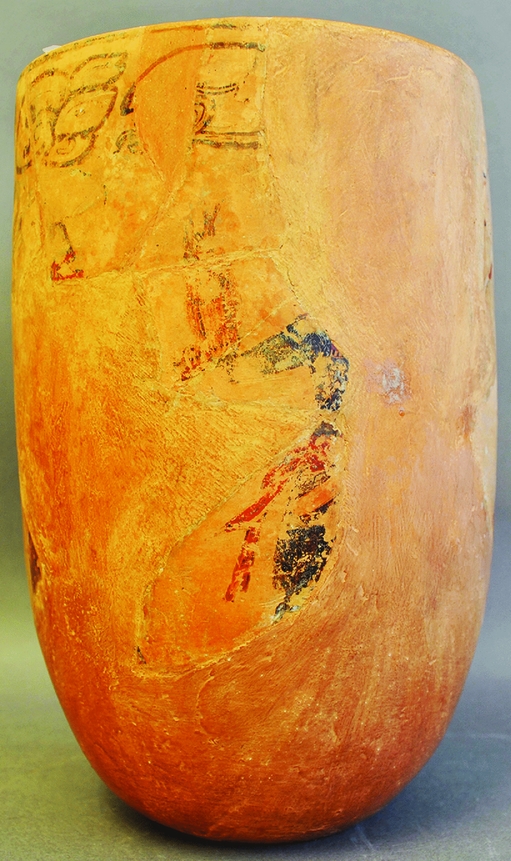The notion of ancient Maya ritual combat, beyond the well-known rubber-ball game played across Mesoamerica, was proposed 40 years ago on the basis of a polychrome vase from southern Belize and a series of Late Classic (AD 700–850) pottery figurines depicting similarly accoutred individuals, found at the site of Lubaantun (Hammond Reference Hammond, Sieveking, Longworth and Wilson1976: figs 4–6).
Visual evidence for interpersonal combat had even then been available for almost half a century on the figurines (e.g. Joyce et al. Reference Joyce, Cooper Clark and Thompson1927, pl. XVIII, fig. 2), but had mistakenly been arrogated to the iconography of the ball-game; Eric Thompson had come close in describing such figures as apparently “dancing or fighting”, one hand inserted into what “in some ways resembles a large boxing-glove” (Joyce et al. Reference Joyce, Cooper Clark and Thompson1927: 309), but he subsequently decided that they were ball-players (e.g. Thompson Reference Thompson1963: 97; Reference Thompson1966: 308), a view unchallenged until 1976.
The unlabelled sherds of the vessel came from the British Museum's 1926–1929 expeditions to British Honduras (now Belize), and were excavated at either Lubaantun, in 1926–1927, or Pusilhà some 32km south-west in 1928–1929 (Joyce et al. Reference Joyce, Cooper Clark and Thompson1927; Joyce Reference Joyce1929). (The vase was not recorded or restored until several decades later, but before 1970, when I photographed it in storage.) The vessel has recently been relocated, re-photographed and given the (belated) designation Am 1997 Q856. It now merits further attention (Figures 1–5).

Figure 1. Maya Late Classic polychrome vessel, probably from Lubaantun, Belize. Restored height 21.5cm. British Museum Am 1997 Q856. Person A.

Figure 2. Polychrome vessel Am 1997 Q856. Person B.

Figure 3. Polychrome vessel Am 1997 Q856. Person C.

Figure 4. Polychrome vessel Am 1997 Q856. Person D.

Figure 5. Polychrome vessel Am 1997 Q856. Person E.
On grounds of paste and style, Lubaantun is almost certainly the source. The vessel tapers from the rim towards the (restored) base, and is of buff, finely tempered fabric, echoing the Louisville Polychrome type established at Lubaantun (Hammond Reference Hammond1975: 315–23). It has a buff slip and is decorated in red, red-brown, black, cream and white—a broad palette compared with many Late Classic polychrome vases. There is some stylistic overlap with the ‘Ballplayer Vase’ fragments excavated at Lubaantun in 1970 (Hammond Reference Hammond1975: fig. 115; Reference Hammond, Sieveking, Longworth and Wilson1976: fig. 1), and close thematic correspondence with numerous helmeted figurines found at Lubaantun (Figures 6–7; Joyce Reference Joyce1933: pls VII–VIII). Such mould-made figurines are found rarely at Pusilhà, and what is known of polychrome style there differs from Lubaantun.

Figure 6. Late Classic Maya mould-made pottery figurine-ocarinas found at Lubaantun by the British Museum in 1926–1927, showing helmeted figures with a distinctive costume including a heavy ‘glove’ on the right hand. Each originally had a three-note sound chamber on the back. Number 1 is 35mm high. From Joyce Reference Joyce1933: pl. VII.

Figure 7. Late Classic figurine-ocarinas from Lubaantun, including two (numbers 1 & 5) showing helmeted persons in close combat. From Joyce Reference Joyce1933: pl. VIII.
Most of the vessel is present, and the lacunae have been skilfully infilled; it has been restored at a height of 21.5cm, with a diameter of 12.8cm. The exact degree of taper to the missing base and the form of that are unknown, but the reconstruction is credible. The hieroglyphic rim inscription, 2.2cm high, is not a Primary Standard Sequence, but the glyphs are elegant and partly readable; Simon Martin (pers. comm. 2015) surmises an ownership statement.
The scene portrayed consists of five standing individuals, here designated as persons A–E, and from their body form and clothing, they are all clearly males (Figures 1–5). The scene seems to begin with person A (for although a major lacuna exists just to his left, one streamer from the headdress of person E, facing away from A, appears just behind him) and moves right around the vase to E.
Person A is red-brown skinned, wearing what is almost a flared and ornamented kilt, black with large red disks and a red fringe (Figure 1). This may be a side view of the ‘thigh-flaps’ noted by Joyce (Reference Joyce1933) on the helmeted Lubaantun figurines, and appears to cover a longer, pale garment, visible both above and below the kilt's margins, although some loss of paint may contribute to this impression. His upper torso is bare, with a rectangular pale area edged in black that seems to represent the (usually vertically) striped chest-cloth seen on many of the Lubaantun helmeted figurines (Figure 6a). He wears a helmet decorated with large red disks, with a visor slit through which his profile can be seen, and with the remains of a crest streaming backwards. He faces to the viewer's right, the torso in twisted profile, his legs apart in a dynamic pose thrusting forward, with the arms up. The right arm is bent and pushed forward at waist height, the left is punching towards person B at shoulder level.
Person B has black-painted skin and stands upright, facing towards A with his left arm down, bent and with the hand/fist across his waist, the right arm up and thrust towards person A (Figure 2). B has a crest on his red and decorated visored helmet, and what looks like a profile water-lily strapped to his left upper arm. He wears a dark kilt with various appendages, and a horizontally striped chest-cloth. A thin red-and-black line runs between the chin-visor of person B and person A's right hand/fist, perhaps denoting interaction.
Behind B (to the viewer's right) is person C, the tallest, similarly dressed to B, and standing with legs astride, not moving forward (Figure 3); long red-and-white streamers hang from his kilt-like garment, as they do on B and E. His left hand, with some sort of binding, seems to rest on his narrow waist and his right (the forearm and hand of which are missing) is in a similar posture: neither of his fists is thrust forward towards an opponent.
Person D is largely missing (Figure 4): what survives is the calf of his right leg (showing black-painted skin) and the visored front of his helmet in red, with the eye visible inside. The top of this (with traces of an elaborate floating crest above) is more or less on the level with B's helmet, so B and D are smaller than C but tallerthan A and possibly E. Person D faces to the viewer's right, and it is clear that he is involved in combat with person E: the tip of his punching arm, wrapped, contacts E's raised right arm just at the base of the protective wrapping and just above the elbow.
Facing him is person E, of whom the black right arm, raised and with protective wrapping up to the elbow, fingers splayed and pointing upwards, is present (Figure 5), as are the proper right side of the torso and right thigh, along with bits of waist-level clothing. The rest of person E is missing.
The overall scene is thus of two pairs of combatants (A+B, D+E) separated by the standing, dynamic, but non-combatant C, perhaps as a referee (as, possibly, is the figure on the ballcourt terracing between two pairs of ball-players on the looted vase K5435 (http://research.mayavase.com/uploads/mayavase/hires/5435.jpg), or perhaps waiting to join in whichever fight is over first). In demonstrating that the helmeted Lubaantun figurines did not, as Joyce (Reference Joyce1933: xix–xxiii) and Thompson (Reference Thompson1963: 97; Reference Thompson1966: 308, 317) asserted, depict ball-game players (Figures 6–7; see Figure 8 for actual ball-player costume at Lubaantun), I previously described the scene on the vase as “some kind of altercation involving the raising of heavily gloved hands: one might almost say that they were having a fight, and that is exactly what I think they are doing” (Hammond Reference Hammond, Sieveking, Longworth and Wilson1976: 106). This
close active juxtaposition […] might reasonably be called ‘combat’: whether this is the combat of warriors in battle, the controlled combat of a sport or the quasi-combat of a ritual, we have no way of telling, although […] the first answer is the least likely. All that we can certainly say is that the activity for which the helmet-glove equipment was required was of fair importance in the iconography and way of life of Classic Lubaantun (Hammond Reference Hammond, Sieveking, Longworth and Wilson1976: 107).

Figure 8. Late Classic figurine-ocarinas from Lubaantun depicting ball-players (numbers 2 & 3) with the distinctive protective belt and, on number 3, the typical right arm-wrapping and knee-pad. From Joyce Reference Joyce1933: pl. V.
We can now, in fact, say rather more, thanks to important studies by Taube and Zender (Reference Taube, Zender, Orr and Koontz2009) and Orr (Reference Orr2003), which show that ritual boxing was, and in places still is, important in Mesoamerican life, employing a variety of costumes and accoutrements; evidence ranges from the Late Preclassic (200 BC–AD 300) at Dainzú in Oaxaca to the present day in Guerrero. Both water and fire deity iconography are known, suggesting to Taube and Zender (Reference Taube, Zender, Orr and Koontz2009: 165) that “the combat reflects a basic dual opposition between igneous and aquatic gods, recalling the Aztec phrase for war, atl-tlachinolli, ‘water and fire’”, with the Jaguar God of the Underworld as “supernatural patron of fire and fire making”. Their identification of jaguar iconography in both modern boxers’ masks and helmeted figures on (looted) Classic vases is matched by some profile Lubaantun figurines (e.g. Taube & Zender Reference Taube, Zender, Orr and Koontz2009: fig. 7.4c, after Hammond Reference Hammond1971: fig. 5) where a jaguar ear is attached to the side of the helmet. Rain/water deity (Chaak) iconography seems absent from the Lubaantun figurines.
Taube and Zender (Reference Taube, Zender, Orr and Koontz2009: 164) endorse my identification of the Lubaantun figurines’ action as ‘combat’, omitting my caveat that sport or ritual are the more probable explanations, battle the least so (Hammond Reference Hammond, Sieveking, Longworth and Wilson1976: 107). They argue for a blend of both in concert with alcohol consumption, often with the purpose of rain-making, and undertaken in an elevated location. Lubaantun, at 50m asl and with annual rainfall well over 3000mm, does not fit this pattern. Ritual boxing, it would seem, was widespread in ancient Mesoamerica, but not restricted to the environments or motives essayed by Taube and Zender.
Acknowledgements
For help with photographs, I am grateful to Kate Jarvis (Figure 4 was taken using flash, Figures 1–3 and 5 with indoor lighting); to Karl Taube for discussion of ritual boxing and ball-games; to Sir Eric Thompson for inspiring interest in the Lubaantun figurines; to the British Museum, Cambridge University, Harvard University, Oxford University and the Wenner-Gren Foundation for funding to support excavation at the site in 1970; and to Peter J. Schmidt, then Commissioner at the Belize Department of Archaeology, for permissions and assistance.












